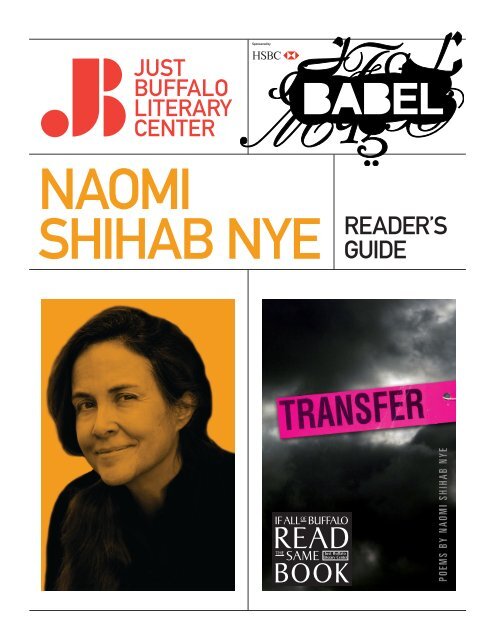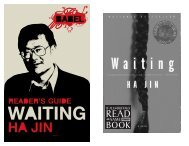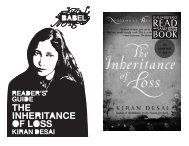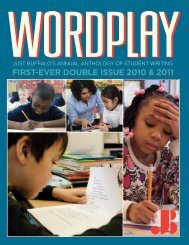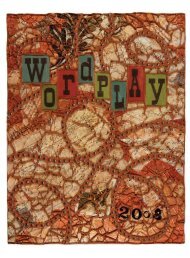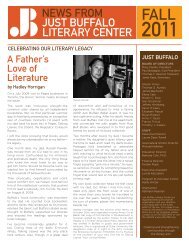Naomi Shihab Nye - Just Buffalo Literary Center
Naomi Shihab Nye - Just Buffalo Literary Center
Naomi Shihab Nye - Just Buffalo Literary Center
- No tags were found...
You also want an ePaper? Increase the reach of your titles
YUMPU automatically turns print PDFs into web optimized ePapers that Google loves.
JUSTBUFFALOLITERARYCENTERSponsored byNAOMISHIHAB NYEREADER’SGUIDE
St. Louis, MissouriFuel (1998), <strong>Nye</strong>’s sixth and most acclaimed poetrycollection, is praised for its ability to span many topics,cultures, time periods and experiences in places she’s livedor visited, from Japan to Texas. A talented musician, shewrites and performs her own songs and has produced twoalbums of music—one of which shares a title with LullabyRaft (1997), a children’s picture book. <strong>Nye</strong> has alsocompiled and edited several anthologies, including theaward-winning This Same Sky: A Collection of Poems fromAround the World (1992), The Tree Is Older Than You Are:A Bilingual Gathering of Poems & Stories from Mexico withPaintings by Mexican Artists (1995) and Is This Forever, orWhat?: Poems and Paintings from Texas (2004).“I never get tired of mixtures,” <strong>Nye</strong> has said. She borrowsfrom Middle Eastern and Native American religions, andwrites of her San Antonio work, “My poems and storiesoften begin with the voices of our neighbors, mostlyMexican American, always inventive and surprising.”<strong>Nye</strong>’s artistic sensitivity and cultural awareness especiallyshine in her well-regarded books for children andteens. Several are autobiographical and intentionallyhighlight female accomplishments and histories. Sitti’sSecrets (1994) tells the story of an Arab-American girland her Arab grandmother set in a Palestinian villagelike the one in which <strong>Nye</strong> once lived. Habibi (1997),<strong>Nye</strong>’s award-winning first young-adult novel, mirrorsher life as an Arab-American teenage girl whose familymoves to Palestine, despite the decades-long violence inJerusalem between Jews and Arabs. Her poetry collectionHoneybee won the 2008 Arab American Book Award inthe Children’s/Young Adult category.3With the destruction of the World Trade <strong>Center</strong> towers onSeptember 11, 2001, <strong>Nye</strong> invoked her heritage again byspeaking out against terrorism and prejudice. Her concernover the lack of understanding between Westerners andArabs led to her publication in 2002 of 19 Varieties ofGazelle: Poems of the Middle East, a collection culled fromyears of writing and a timely finalist for the NationalBook Award. In the bestselling You and Yours (2005), <strong>Nye</strong>revisits the Middle East more intimately as a mother anda traveler. Her latest work includes the poetry collection,Transfer (2011), and a forthcoming collection of veryshort stories, There Is No Long Distance Now (2012).Transfer is a mixture of short free verse poems, longernarrative pieces and prose poems. <strong>Nye</strong> dedicates thebook to her father’s story as a proud yet heartbrokenPalestinian immigrant. Aziz, also a poet and writer, was aquick-witted, outgoing news reporter who was passionateabout his homeland. In one section, <strong>Nye</strong> includes 11 ofher father’s poems, “transferring” her book to him. Aziz<strong>Shihab</strong>’s words illustrate how devastated he was by hisfamily’s forced exodus from Jerusalem following Israel’srise to power, and how he lived the rest of his days inthe United States with a refugee’s embittered hopes ofreturning home. “I immigrated to the land of the free,but my people weren’t free,” he writes in his poem, “Wedid not have drinking water in the middle of the ocean.”Transfer also touches on the ethnic diversity of <strong>Nye</strong>’sSan Antonio, and her experiences abroad in cities likeJerusalem and Cairo, to create a collection that bearswitness to a shared narrative—what she writes is a “largefamily of voices linking human experience. We haveno borders when we read.” According to the publisher,BOA Editions, “At the center of these poems is a lookinginward, a questioning of things that help the traveler andof things that should help the traveler but for some reasondo not.”<strong>Nye</strong> subtly navigates the various meanings of “transfer”to convey, carry and send the subject (and her readers)on their own journeys. Physical objects, as well asthoughts, are moved, lost or forgotten and pickedup again. Airplanes are boarded, and home addresseschange along with perspectives. <strong>Nye</strong> negotiates her innerconflict at living in the comfort and safety of America,removed geographically from Arab struggles abroad (asin “Burlington, Vermont”). She documents Americanexperiences: the blank stare of a 99-cent store in “Dallas,”
San Antonio<strong>Nye</strong>’s writing also centers on San Antonio, her longtimehome and a city of immigrants—a melting pot ofLatino, black, white, Palestinian and other ethnic groupswho settled in Texas. As a Palestinian-American artist,educator, wife and mother who lives and works there fulltime, she knows what it’s like to simultaneously belongand stand apart. Her poem “San Antonio,” from Is ThisForever, or What? Poems and Paintings from Texas, reflectson her ties to this historic Mexican-American townsteeped in legends of the Alamo and Native Americanmyth:I remembered the old menin the west side café,dealing dominoes like magical charms.It was then I knew,like a woman looking backward,I could not leave you,or find anyone I loved more.And her role there has been unequivocally devoted tobreaking down cultural barriers; she once invited all the<strong>Nye</strong>s in the San Antonio phonebook to her house fordinner.In the Southwestern Writers Collection anthology,What Wildness Is This: Women Write about the Southwest,(2007), <strong>Nye</strong>’s short story, “Home Address,” describes theproud day she pays off her family’s mortgage on theirold home near the San Antonio River. She feels as fullyat home in the Texas “wilderness” and San Antonio’sethnically diverse neighborhoods as she does acrossthe ocean with her family in war-torn Palestine. It isthis search for belonging amidst cultural contrasts andupheaval that gives her writing its power. She says she feltconfident in representing Mexican-American voices inher anthology, The Tree is Older Than You Are, because “Ilive in one of the most Mexican of U.S. cities, in an innercityneighborhood where no dinner table feels completewithout a dish of salsa for gravity, and the soft air humsits double tongue… I suggest that blood be bigger thanwhat we’re born with.”9/11<strong>Nye</strong> became more acutely politicized when she joinedthe world in decrying the World Trade <strong>Center</strong> attacks onSeptember 11, 2001. She often tells the story of a post-9/11 taxi ride she once took in Syracuse, New York, andhow her interchange with the driver became the themeof 2007’s I’ll Ask You Three Times, Are You OK?: Tales5of Driving and Being Driven. As she recounts it in aninterview the year the book came out:He came to pick me up in the dark. He said,‘because we’re living is such strange times, weshould ask each other regularly if we are, youknow, okay.’ Between my hotel and the airporthe made it a habit to ask a minimum of threetimes. So after he told me this, he paused andsaid, ‘Are you okay?’ And I said, ‘I was, until Imet you.’In the same interview and another with Bill Moyers,<strong>Nye</strong> recalls feeling a surge of memories about hergrandmother after the planes hit the twin towers—asense of responsibility to her Arab heritage that, informedby her world travels, led her to both critique and defendMuslim society. In “Jerusalem,” a poem included in 19Varieties of Gazelle, she connects the violence of 9/11 tothe ongoing bloodshed in Israel and Palestine, and thenbluntly urges us to look beyond hate and incrimination:“I’m not interested in who suffered the most. I’minterested in people getting over it.”Over the years, <strong>Nye</strong>’s feelings have matured from whenshe lived in the Middle East as a teenager. “I do thinkthat as we get older, sometimes we examine culture indifferent ways, how it has affected our own lives, how ourculture parallels things…in other people’s cultures, howthose variations can actually bring us together.”Empathy for different cultures, she insists, comes fromlistening to each other’s stories, and teaching poetry is apowerful yet under-represented way to open students’ eyesto the world. “I can never understand it when teachersclaim they are ‘uncomfortable’ with poetry—as if poetrydemands they be anything other than responsive, curioushuman beings,” she once said. “If poetry comes out ofthe deepest places in the human soul and experience,shouldn’t it be as important to learn about one another’spoetry, country to country, as one another’s weather orgross national products?”The poet William Stafford once called <strong>Nye</strong>’s work “apoetry of encouragement and heart.” In Transfer, as in somany of her other works, her poems speak to us withhopefulness in their own languages. In this book as wellas her others, <strong>Naomi</strong> <strong>Shihab</strong> <strong>Nye</strong> uses her life’s journeysto find a dialogue with the world.
Readers Questions1. Does the title “Transfer” have one meaning, or many?How does it (or how do they) help define what <strong>Naomi</strong><strong>Shihab</strong> <strong>Nye</strong> is exploring in these poems?2. <strong>Naomi</strong> <strong>Shihab</strong> <strong>Nye</strong> tells students who are skepticalabout poetry: “Do you think in complete, elaboratesentences? In fully developed paragraphs withcareful footnotes? Or in flashes and bursts of images,snatches of lines leaping one to the next, descriptivefragments, sensory details? We think in poetry.” Doyou agree? How do the poems in Transfer illustratethis claim?3. How is <strong>Nye</strong>’s poetry different from her father’s? Howis it similar? Give some examples.4. Do you think the collection is more powerful andcoherent with the inclusion of Aziz’s poetry? Why orwhy not?5. What is missing from Aziz’s life that makes him sohomesick? Why does <strong>Nye</strong> describe him as a “refugee/not always”? When is he, and when isn’t he a refugee?6. A recurring theme in Transfer is the shifting placecalled “home,” and how traveling affects one’sdefinition of home. What does “home” mean in<strong>Nye</strong>’s poems as well as in her father’s? Find specificexamples.7. How does <strong>Nye</strong> incorporate and connect currentevents with history in her poetry? How does thisechoing of her late father’s profession in journalismimpact her poems?8. Identify some of the commonplace objects (i.e.stones, cucumbers, fig leaves, lentil soup, etc.) that<strong>Nye</strong> mentions. What do they signify in terms ofher memories of her father? Of her relationship toher surroundings? Why are these seemingly smallphysical objects so important to her?9. What role does food play in both <strong>Nye</strong>’s poems andher father’s? Find some examples.10. Throughout Transfer, <strong>Nye</strong> refers to “dialogue”—between her and her father in her memories of whenhe was alive, and in terms of her own identity as apoet and a teacher. Find some poems that illustratethis. How do you understand the lines: “we droppedour troubles / into the lap of the storyteller / and theyturned into someone else’s”?11. In Aziz’s poems, what is his attitude toward Palestineas an adult living in the United States? How does hefeel about Israel’s invasion of his people’s traditionalhomeland?12. How does Aziz cope with his loneliness anddisconnection as a refugee?13. How would you answer his question in “EverythingIn Our World Did Not Seem To Fit”: “Why wassomeone else’s need for a home / greater than our ownneed for our own homes”? To what is he referring?14. Go back and reread the poem, “Fifty Years Since IPrayed Or Thought In Arabic.” What importancedoes Aziz give to journalism, to reporting news, andto language itself? What made his professional work“magical” to him, and how might that magic beimportant to Palestinians as a whole? Find exampleswhere <strong>Nye</strong> describes the magic and power of words.15. What effect does war in the Middle East have onAziz and <strong>Nye</strong> throughout their lives? Give specificexamples in these poems.16. Both Aziz and <strong>Nye</strong> write about memory—distinctrecollections and flashbacks of conversations, people,objects and places. Give some examples and explainhow each poem succeeds in illustrating that specificmemory. Is it through emotion or detail, or both?17. What are some memories both daughter and fatherare fearful of losing, and others they know they havealready lost?18. What is hopeful about the poetry in Transfer?6
19. Find some examples where <strong>Nye</strong> uses humor or comicrelief to give lightness to a dark situation, where sheputs on her “armor of joy.” How is her use of humoreffective? How does it change the meaning of thepoems?20. Which is your favorite poem? Least favorite? Explainwhy, using some of the themes discussed above.Selected BibliographyPoetryDifferent Ways to Pray, Breitenbush (Portland, OR) 1980.On the Edge of the Sky, Iguana Press (Madison, WI) 1981.Hugging the Jukebox, Dutton (New York, NY) 1982.Yellow Glove, Breitenbush (Portland, OR) 1986.Invisible, Trilobite (Denton, TX) 1987.Red Suitcase, BOA Editions (Rochester, NY) 1994.Words under the Words: Selected Poems, Far Corner Books(Portland, OR) 1995.Fuel, BOA Editions (Rochester, NY) 1998.Anthologies(Editor) This Same Sky: A Collection of Poems from around theWorld, Four Winds Press (New York, NY) 1992.(Editor) The Tree Is Older Than You Are: Poems and Stories fromMexico, Simon & Schuster (New York, NY) 1995.(Editor, with Paul Janeczko) I Feel a Little Jumpy Around You:A Book of Her Poems and His Poems Collected in Pairs, Simon& Schuster (New York, NY) 1996.(Selector) What Have You Lost? (young-adult poetry), withphotographs by husband, Michael <strong>Nye</strong>, Greenwillow Books(New York, NY) 1999.(Selector) Salting the Ocean: 100 Poems by Young Poets,illustrated by Ashley Bryan, Greenwillow Books (New York,NY) 2000.Come with Me: Poems for a Journey, with images by DanYaccarino, Greenwillow Books (New York, NY) 2000.(With others) The Space between Our Footsteps: Poems andPaintings from the Middle East, Simon & Schuster (New York,NY), 1998, published as The Flag of Childhood: Poems from theMiddle East, Aladdin (New York, NY) 2002.Nineteen Varieties of Gazelle: Poems of the Middle East,Greenwillow Books (New York, NY) 2002.Is This Forever, or What? Poems and Paintings from Texas,Greenwillow Books (New York, NY) 2004.Sweet Sifter in Time: Poems for Girls, illustrated by TerreMaher, Greenwillow Books (New York, NY) 2005.Picture BooksSitti’s Secrets, illustrated by Nancy Carpenter, Macmillan (NewYork, NY) 1994.Benito’s Dream Bottle, illustrated by Yu Cha Pak, Simon &Schuster (New York, NY) 1995.Lullaby Raft, illustrated by Vivienne Flesher, Simon &Schuster (New York, NY) 1997.Baby Radar, illustrated by Nancy Carpenter, GreenwillowBooks (New York, NY) 2003.OtherTattooed Feet (chapbook) 1977.Eye-to-Eye (chapbook), 1978.Recordings include Rutabaga-Roo (songs), Flying Cat(San Antonio, TX), 1979; Lullaby Raft, Flying Cat (SanAntonio, TX), 1981; and The Spoken Page (poetry reading),International Poetry Forum (Pittsburgh, PA), 1988.Mint (prose) State Street Press (Brockport, NY) 1991.Never in a Hurry (essays for young adults), University of SouthCarolina Press (Columbia, SC) 1996.Habibi (novel for young adults), Simon & Schuster (NewYork, NY) 1996.7
JUST BUFFALO PRESENTSSponsored by byWith additional support from:Readers Guide Written by Lauren Newkirk MaynardDesigned by Julian Montague<strong>Just</strong> <strong>Buffalo</strong> <strong>Literary</strong> <strong>Center</strong>, Market Arcade, 617 Main St., Suite 202A, <strong>Buffalo</strong>, NY 14203Ticket Information and Purchases: Phone: 716.832.5400 Fax: 716.270.0184www.justbuffalo.org/babel


